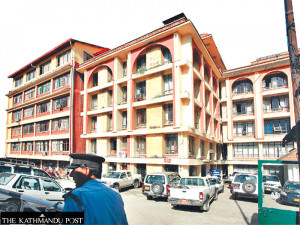Entertainment
Of nature
Inter-Linkage between Art and Environment is designed to explore the manners in which traditional art—paubha paintings and Mithila art—depict, portray and even revere nature
Rachana Chettri
The exhibit is made up of a rich collection of paintings by traditional Newar and Maithili artists (over a 100 of them have participated) working in their respective forms. The NAC building—the revamp associated with the four month-long Climate+ Change exhibition still excellently maintained—is currently home to not just an impressive collection of artworks but also a vibrant community of artists, curators, art students and visitors. Silence, the most salient feature of any art gallery in the city, has been replaced by a steady hum and buzz. On June 8, on the ground floor, where traditional paintings from the Mithila region are exhibited, there was a group of students from Janakpur and Kathmandu bending over a large, intricately patterned piece of paper—an Aripan, a traditional floor drawing in Mithila art. On the first floor, where an extensive collection of modern-day paubha paintings and reproductions and replicas of older images derived from ancient Newar scripts are on exhibit, noted paubha artist Lok Chitrakar was busy at work demonstrating the intricate process of applying colour on a paubha painting. Glittering crystals of blue and yellow mineral rocks were placed alongside mortars and pestles where they were ground
to the fine powder with which the many gods of Buddhist
and Hindu scriptures are given life to in these traditional paintings.
“Paubha is characterised by its highly disciplined approach to painting. There are specific rules to be followed here; a colour cannot be used on a particular deity or motif because the artist feels the two would complement each other, but must be used because that is what fits within the confines of tradition,” said Chitrakar. “Imagination must not be unleashed but kept restrained here,” he added. Paubha, the ancient Newari style of painting that is believed to have first emerged in the Kathmandu Valley in the fifth century AD and later influenced the more widely-recognised Tibetan thangka style, is characterised by its adherence to the specific rules that bind it to its centuries old origins. “If a certain god is painted in a style other than that stated for him/her in the scriptures, the painting ceases to be a paubha altogether,” said a young paubha apprentice painter as he attempted to explain the intricacies of the style to curious exhibition-goers. “Madan Sir, however, has incorporated his own style and technique in the little space available for improvisation—mostly in the backgrounds of paubha paintings—in his work,” he added, explaining that the little room for improvisation made available in paubha paintings means that while the deities themselves might be fixed always, each painting is unique because the combinations in which the additional elements of the paintings might be executed and presented, though still bound in
rules and symbolism, are potentially endless.
The NAC is currently a repository of contemporary efforts at maintaining the paubha tradition in the country in this sense. There are also a few attempts at giving this highly scripture- and ritual-driven work of art a more ‘modern’ or ‘contemporary’ feel. There are instances where paubhas have been painted over unconventional surfaces—a piece of wood and a nanglo—on exhibit. Also interesting to observe are the re-interpretations of scriptural symbols in more contemporary artworks. Long before abstract art had made headways in the modern art scene, ancient Newar artists from the Valley were representing concepts and ideas—abstractions, essentially—in strange, geometric patterns and forms.
Although there is nothing explicitly ‘environmental’ about the paintings that are part of the exhibit, they bring audience attention to the high regard with which ancient Nepali traditions viewed the environment. ‘Nature’ might be the more appropriate word here, but the point still remains that age-old traditions in this country (and beyond) have always viewed man in relation to nature. Whether it be the colourful scapes of Mithila art where women, men and children; trees, birds and fish; and gods, muses and goddesses sing and dance in harmony or the intricately executed, and highly detailed
paubha canvases where god and nature come together—both as objects of reverence, both captured with such care and specification that it is quite possible to spend hours in front of one paubha painting examining all the details with which the artist has adorned their canvas—these works of art are representations of man’s relationship with nature. At a point in human history where man is too wont to forget where he comes from and where the objects with which he makes life more comfortable for himself are all ultimately derived from, exhibitions such as this one are valuable in trying to remind us that we too are of nature and must always treat her with the respect and reverence she deserves.
The exhibition continues till June 15. An artist’s dialogue and talk with Dina Bangdel begins today at 3:30 pm




 19.42°C Kathmandu
19.42°C Kathmandu












